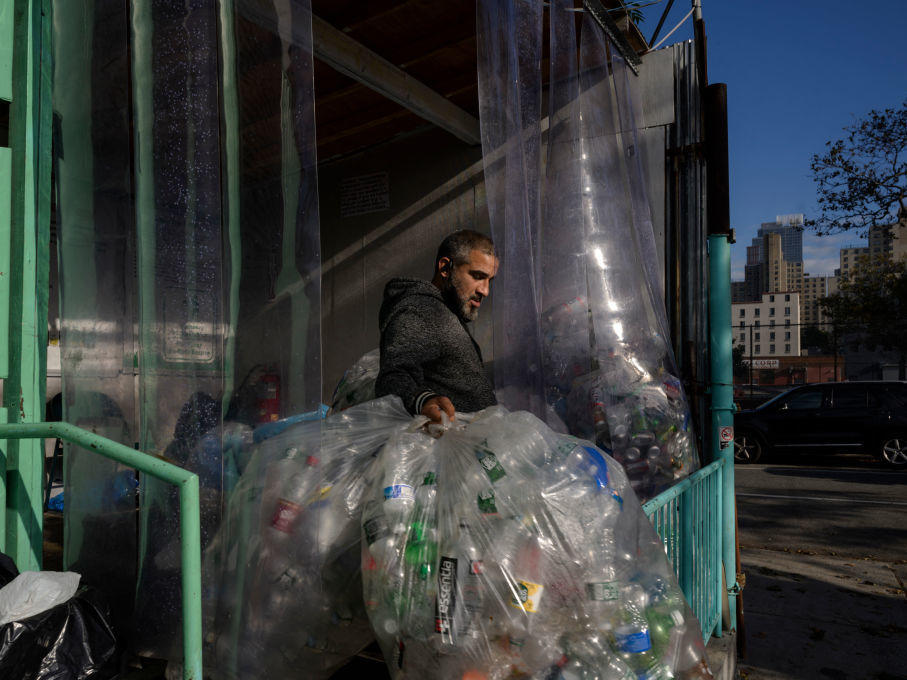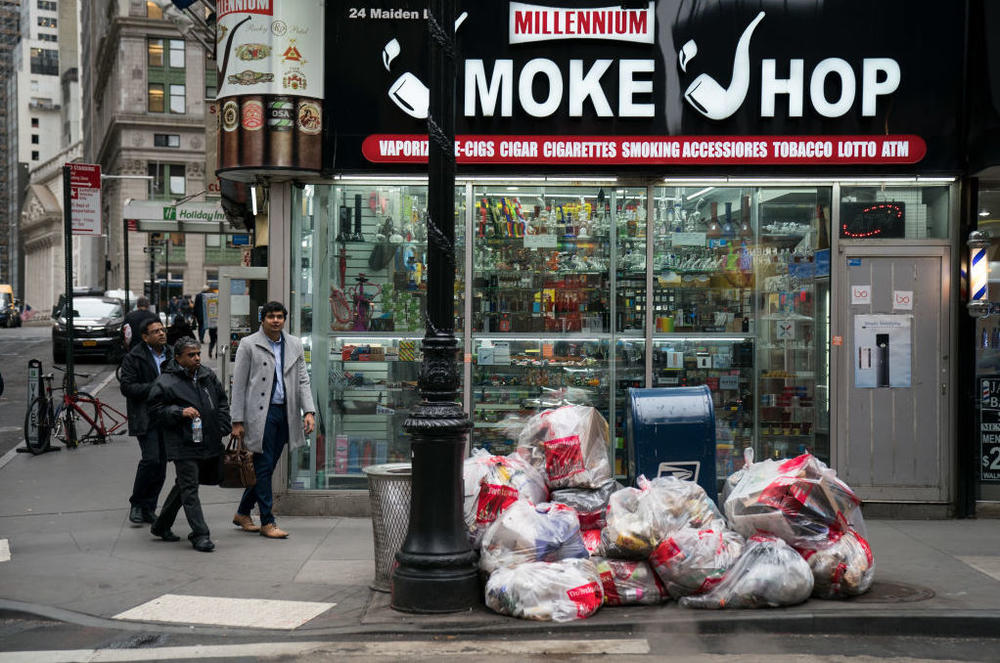Section Branding
Header Content
We never got good at recycling plastic. Some states are trying a new approach
Primary Content
After recycling's failure to appreciably reduce the amount of plastic the U.S. throws away, some states are taking a new approach, transferring the onus of recycling from consumers to product manufacturers.
In the past 12 months, legislatures in Maine, Oregon and Colorado have passed "extended producer responsibility" laws on packaging. The legislation essentially forces producers of consumer goods — such as beverage-makers, shampoo companies and food corporations — to pay for the disposal of the packages and containers their products come in. The process is intended to nudge manufacturers to use more easily recyclable materials, compostable packaging or less packaging.
Now, the New York legislature is deliberating two extended producer responsibility bills as its session nears its June 2 close. Lobbying by business and environmental groups has been particularly intense around details such as what recycling goals must be met and who sets them. Industry and environmentalists alike believe that when a state as big as New York adopts a law, it creates a template or standard that other states might adopt too.
"I'm exhausted," said Judith Enck, founder and president of the advocacy group Beyond Plastics, who has been lobbying legislators on the issue. "If you have a state the size of New York get it wrong on extended producer responsibility, it would have a ripple effect on other states."
What would this approach look like?
Extended producer responsibility — the ungainly name comes from a 1990 paper by Swedish academics Thomas Lindhqvist and Karl Lidgren — took root in Europe 30 years ago. Many U.S. states have such policies for e-waste and mattresses. But their adoption for packaging is fairly recent in the U.S., and those programs won't be fully up and running for years.
While each state's legislation varies, the system generally works like this:
- Beverage companies, shampoo-makers, food manufacturers and other producers will keep track of how much of each sort of packaging they use.
- These producers will reimburse government recycling programs for handling the waste, either directly or through a consortium called a "producer responsibility organization."
- Fees will be lower for companies that use easily recyclable, compostable or even reusable packaging, a mechanism that supporters say will provide incentives to adopt more sustainable practices.
- Recycling centers will use the money to cover their operating costs, expand outreach and education, and invest in new equipment.
"We think corporations will produce less virgin materials because they are charged by the amount they put out there, and certainly less eco-unfriendly materials," said New York state Sen. Todd Kaminsky, a Democrat from Long Island who sponsored one of the bills pending in Albany.
To consumers, the recycling system would pretty much stay the same. But the packaging around consumer products would likely look different. If the incentives worked, there'd be less packaging overall, and whatever packaging that would be used would be made more often of compostable or easily recyclable materials, such as glass or aluminum.
"Packaging doesn't have to be the way we know it," Kaminsky said. "Why in a box of cereal is there packaging within other packaging? You know, you reach into the box, and there's a sleeve containing Cheerios or something. But when you get potato chips, it's just in the sleeve. There's no box around it. Why is that?"
Recycling isn't enough to reduce plastic waste
Recycling rates in the U.S. have stagnated over the past decade at around 30% to 35% across all materials in the waste stream; the recycling rate of plastics — a growing form of packaging — is much lower. The Environmental Protection Agency estimated in 2018 that only 8.5% of plastic refuse was recovered to produce new products. (Two environmental groups recently estimated the real recycling rate to be even lower, given that not all recovered plastics end up being recycled.)
The burden of recycling falls not just on consumers to sort their containers properly, but also on cities and counties, where officials once thought recycling could pay for itself. But that has not been the case, especially because of recent decisions by China and other Asian countries to refuse to accept plastic waste imports. In 2021, the WWF calculated that the management of plastic waste costs about $32 billion a year worldwide.
The Business Council of New York State, which represents 3,500 companies and chambers of commerce, opposes both measures that have been advanced in Albany.
"Such radical change will be costly, will carry its own risks of unintended consequences, and simply is not necessary to improve the state's recycling and waste reduction outcomes," the business group said in an open letter.
But some national corporations and plastics manufacturers have been more supportive, to an extent. The Recycling Partnership, a group funded by corporations such as General Mills, Coca-Cola and Exxon Mobil (which, as an oil and gas company, provides the raw materials for plastics), has endorsed the idea, so long as producers maintain some control over the fees and targets in the new system. (Exxon Mobil is a financial sponsor of NPR.)
"How could you possibly run a system of this scale and get companies ultimately to change their packaging design, possibly shift to using more sustainable materials — how could we possibly do that without their participation?" said Michael Washburn, a senior policy adviser at the organization.
The question of just how or whether companies get to regulate themselves is the biggest point of contention in the New York legislature right now. Kaminsky's bill, which the Recycling Partnership supports, calls for producers to come up with their own targets, both for how much recyclable material will be used in their packaging and for how much of their packaging will be recycled. Those targets would then be reviewed by an advisory board of representatives from environmental groups and recycling agencies, as well as manufacturers. Ultimately, these plans would be approved by the state's Department of Environmental Conservation.
The rival bill, sponsored by Assemblymember Steven Englebright, also a Long Island Democrat, stipulates those targets directly. Companies would have to decrease the amount of their nonreusable packaging by 50% over the first 10 years. (Both bills make exceptions for small businesses.)
"We need specific requirements," said Enck, who is also a former EPA official and favors Englebright's bill over Kaminsky's. "You just don't hand the keys of the car over to the plastics industry. We wouldn't expect the tobacco industry to solve the problem of smoking. Why would we expect the packaging industry to solve the problem of overpackaging?"
Some people don't think this is the way to go
Some government watchdogs are skeptical about the whole concept of extended producer responsibility. Germany, which adopted the policy in the early 1990s, is well known for its high recycling rates. But those rates count waste-to-energy, which requires incineration, as a form of recycling, and the country is still one of the world's highest plastics consumers per capita.
"The Americans are saying, 'It's successful.' Well, it's not successful," said Neil Seldman, director of the Waste to Wealth Initiative at the Institute for Local Self-Reliance.
(Germany, however, does not require manufacturers to reduce their packaging the way that Englebright's bill would.)
California could take a slightly different approach this fall to reduce packaging and increase recycling. A measure on the ballot there would impose an extended producer responsibility system on the state in conjunction with a 1-cent fee on every piece of single-use plastic packaging.
In New York, lobbyists on both sides of the issue say negotiations are underway to get some sort of bill passed in the week remaining in the current legislative session. And if that doesn't happen, they say they will be back next year with another push.
Copyright 2022 NPR. To see more, visit https://www.npr.org.


